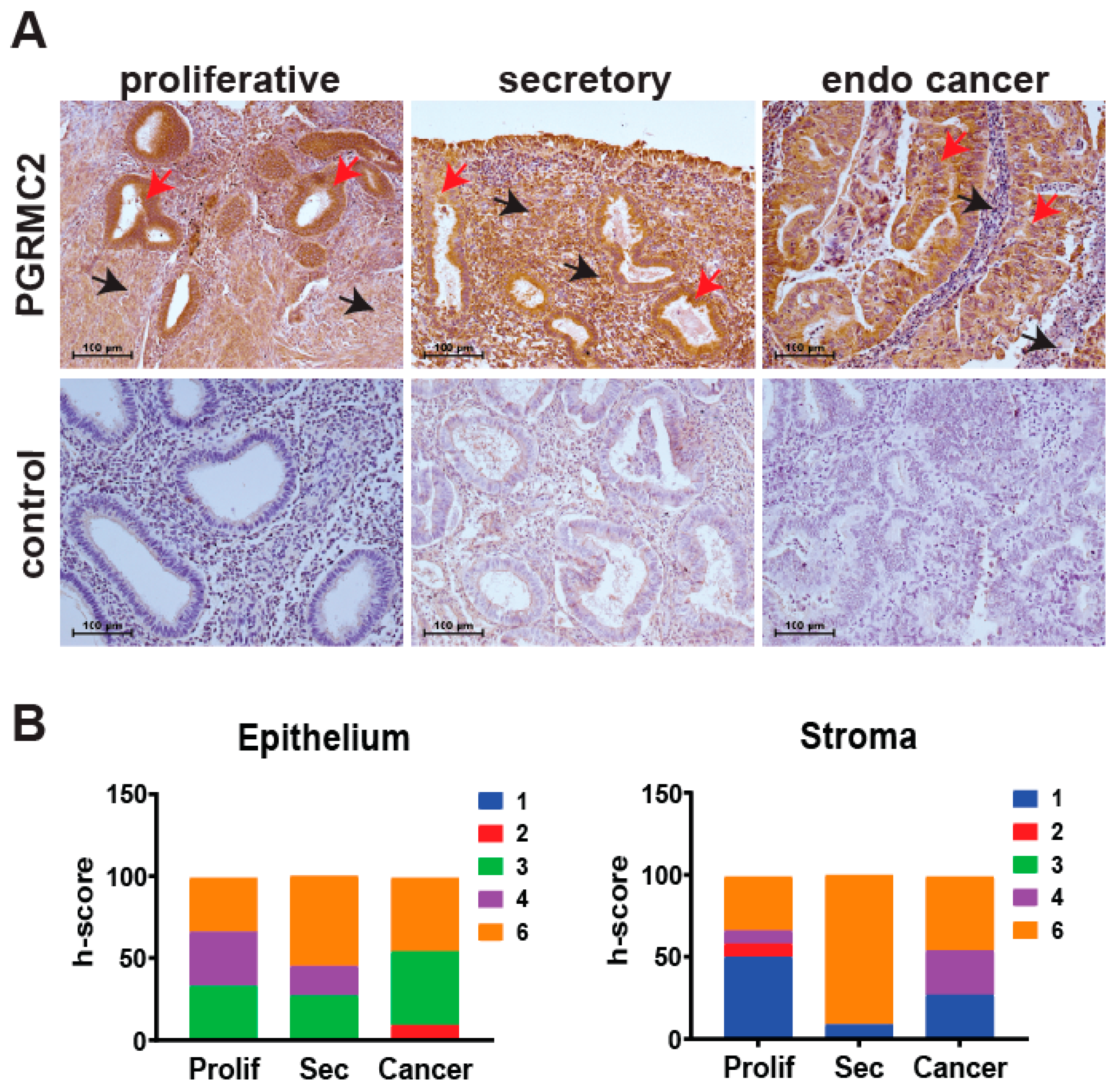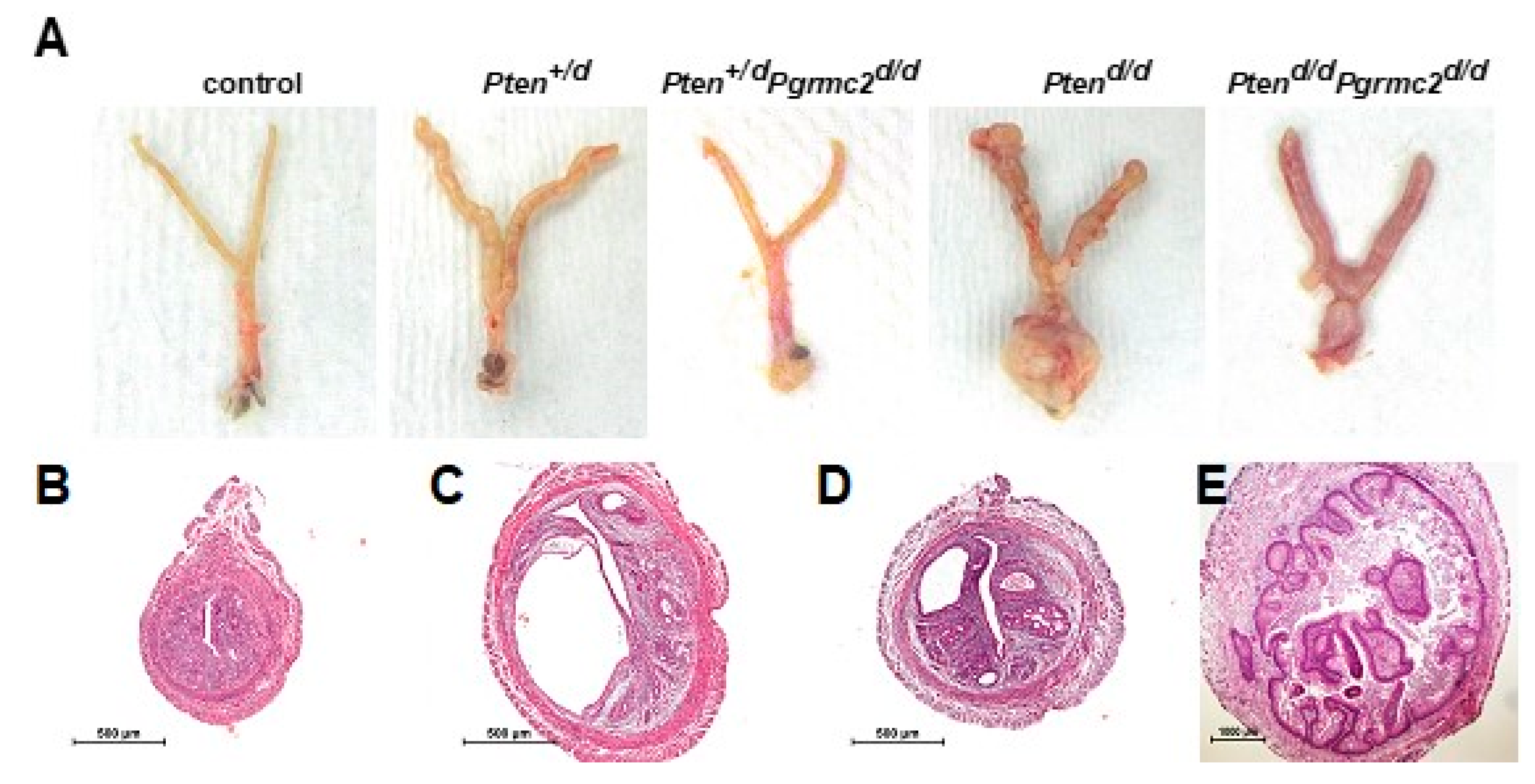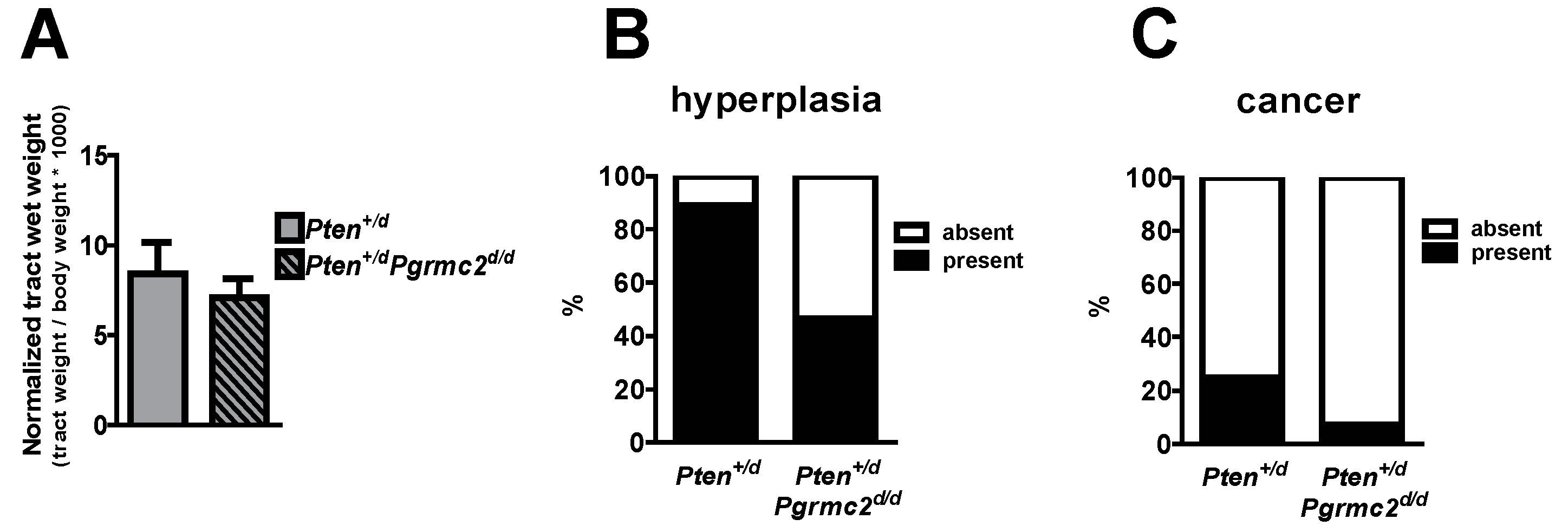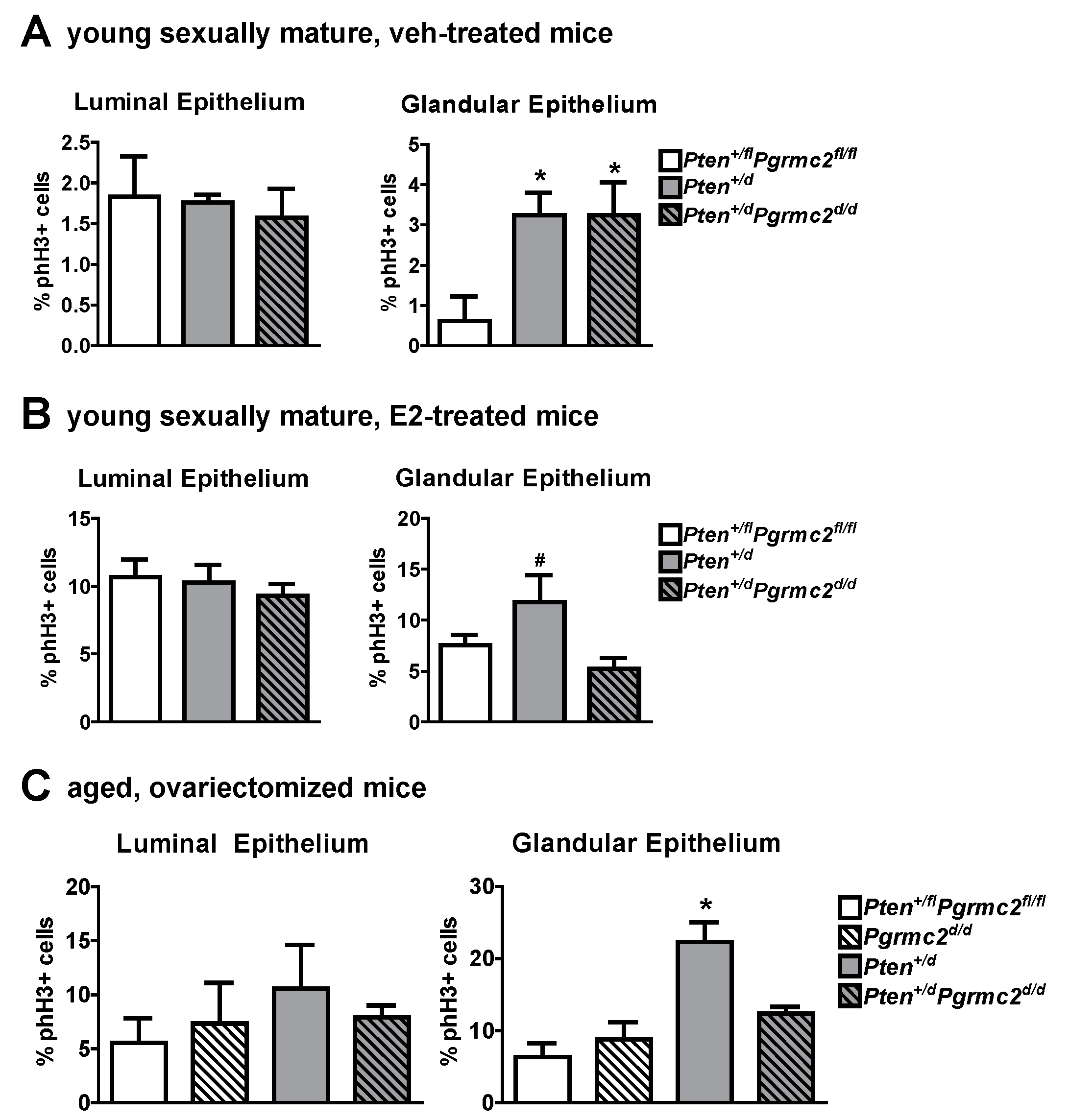Uterine Pgrmc2 Deficiency Attenuates Endometrial Hyperplasia and Cancer and Prolongs Lifespan in a Pten Loss-of-Function-Induced Cancer Model
Simple Summary
Abstract
1. Introduction
2. Materials and Methods
2.1. Animals
2.2. Histology and Immunohistochemistry
2.3. RNA Isolation and qPCR
2.4. Data Analyses
3. Results
3.1. PGRMC2 Expression in Human Endometrium and Endometrial Carcinoma
3.2. Pgrmc2 Deficiency Reduces the Incidence and Severity of Pten Loss-of-Function-Induced Endometrial Hyperplasia and Carcinoma
4. Discussion
5. Conclusions
Author Contributions
Funding
Institutional Review Board Statement
Informed Consent Statement
Data Availability Statement
Conflicts of Interest
References
- Available online: https://www.cancer.org/cancer/types/endometrial-cancer/about/key-statistics.html (accessed on 1 January 2025).
- Kim, J.J.; Kurita, T.; Bulun, S.E. Progesterone action in endometrial cancer, endometriosis, uterine fibroids, and breast cancer. Endocr. Rev. 2013, 34, 130–162. [Google Scholar] [PubMed]
- Hollander, M.C.; Blumenthal, G.M.; Dennis, P.A. PTEN loss in the continuum of common cancers, rare syndromes and mouse models. Nat. Rev. Cancer 2011, 11, 289–301. [Google Scholar] [PubMed]
- Wallace, A.E.; Gibson, D.A.; Saunders, P.T.K.; Jabbour, H.N. Inflammatory events in endometrial adenocarcinoma. J. Endocrinol. 2010, 206, 141–157. [Google Scholar] [PubMed]
- Kong, D.; Suzuki, A.; Zou, T.T.; Sakurada, A.; Kemp, L.W.; Wakatsuki, S.; Yokoyama, T.; Yamakawa, H.; Furukawa, T.; Sato, M.; et al. PTEN1 is frequently mutated in primary endometrial carcinomas. Nat. Genet. 1997, 17, 143–144. [Google Scholar]
- Daikoku, T.; Hirota, Y.; Tranguch, S.; Joshi, A.R.; DeMayo, F.J.; Lydon, J.P.; Ellenson, L.H.; Dey, S.K. Conditional loss of uterine Pten unfailingly and rapidly induces endometrial cancer in mice. Cancer Res. 2008, 68, 5619–5627. [Google Scholar]
- Daikoku, T.; Jackson, L.; Besnard, V.; Whitsett, J.; Ellenson, L.H.; Dey, S.K. Cell-specific conditional deletion of Pten in the uterus results in differential phenotypes. Gynecol. Oncol. 2011, 122, 424–429. [Google Scholar]
- Podsypanina, K.; Ellenson, L.H.; Nemes, A.; Gu, J.; Tamura, M.; Yamada, K.M.; Cordon-Cardo, C.; Catoretti, G.; Fisher, P.E.; Parsons, R. Mutation of Pten/Mmac1 in mice causes neoplasia in multiple organ systems. Proc. Natl. Acad. Sci. USA 1999, 96, 1563–1568. [Google Scholar]
- Cheng, H.; Liu, P.; Zhang, F.; Xu, E.; Symonds, L.; Ohlson, C.E.; Bronson, R.T.; Maira, S.M.; Di Tomaso, E.; Li, J.; et al. A genetic mouse model of invasive endometrial cancer driven by concurrent loss of Pten and Lkb1 is highly responsive to mTOR inhibition. Cancer Res. 2014, 74, 15–23. [Google Scholar]
- Wang, X.; Wendel, R.H.; Emerson, R.E.; Broaddus, R.R.; Creighton, C.J.; Rusch, D.B.; Buechlein, A.; DeMayo, F.J.; Lydon, J.P.; Hawkins, S.M. Pten and Dicer1 loss in the mouse uterus causes poorly differentiated endometrial adenocarcinoma. Oncogene 2020, 39, 6286–6299. [Google Scholar]
- Terakawa, J.; Serna, V.A.; Taketo, M.M.; Daikoko, T.; Suarez, A.A.; Kurita, T. Ovarian insufficiency and CTNNB1 mutations drive malignant transformation of endometrial hyperplasia with altered PTEN/PI3K activities. Proc. Natl. Acad. Sci. USA 2019, 116, 4528–4537. [Google Scholar]
- Falkenstein, E.; Meyer, C.; Eisen, C.; Scriba, P.C.; Wehling, M. Full-length cDNA sequence of progesterone membrane-binding protein from porcine vascular smooth muscle cells. Biochem. Biophys. Res. Comm. 1996, 229, 86–89. [Google Scholar] [CrossRef] [PubMed]
- Gerdes, D.; Wehling, M.; Leube, B.; Falkenstein, E. Cloning and tissue expression of two putative steroid membrane receptors. Biol. Chem. 1998, 379, 907–911. [Google Scholar] [PubMed]
- Meyer, C.; Schmid, R.; Scriba, P.C.; Wehling, M. Purification and partial sequencing of high-affinity progesterone-binding sites(s) from porcine liver membranes. Eur. J. Biochem. 1996, 239, 726–731. [Google Scholar] [CrossRef] [PubMed]
- Peluso, J.J.; Pru, J.K. Non-canonical progesterone signaling in granulosa cells function. Reproduction 2014, 147, R169–R178. [Google Scholar] [CrossRef]
- Clark, N.C.; Pru, C.A.; Yee, S.P.; Lydon, J.P.; Peluso, J.J.; Pru, J.K. Conditional ablation of progesterone receptor membrane component 2 causes female premature reproductive senescence. Endocrinology 2016, 158, 640–651. [Google Scholar] [CrossRef]
- McCallum, M.L.; Pru, C.A.; Niikura, Y.; Yee, S.P.; Lydon, J.P.; Peluso, J.J.; Pru, J.K. Conditional ablation of progesterone receptor membrane component 1 results in subfertility in the female and development of endometrial cysts. Endocrinology 2016, 157, 3309–3319. [Google Scholar] [CrossRef]
- Lodde, V.; Barros, R.G.; Terzaghi, L.; Franciosi, F.; Luciano, A.M. Insights on the role of PGRMC1 in mitotic and meiotic cell division. Cancers 2022, 14, 5755. [Google Scholar] [CrossRef]
- Sabbir, M.G. Progesterone induced Warburg effect in HEK293 cells is associated with post-translational modifications and proteasomal degradation of progesterone receptor membrane component 1. J. Steroid Biochem. Mol. Biol. 2019, 191, 105376. [Google Scholar] [CrossRef]
- Xu, X.; Ruan, X.; Wang, Z.; Yang, Y.; Cheng, J.; Gu, M.; Mueck, A.O. Progesterone receptor membrane component-1 may promote survival of human brain microvascular endothelial cells in Alzheimer’s Disease. Am. J. Alzheimers Dis. Other Demen 2022, 37, 15333175221109749. [Google Scholar] [CrossRef]
- Ahmed, I.S.; Rohe, H.J.; Twist, K.E.; Craven, R.J. Pgrmc1 (progesterone receptor membrane component 1) associates with epidermal growth factor receptor and regulates erlotinib sensitivity. J. Biol. Chem. 2010, 285, 24775–24782. [Google Scholar] [CrossRef]
- Rohe, H.J.; Ahmed, I.S.; Twist, K.E.; Craven, R.J. PGRMC1 (progesterone receptor membrane component 1): A targetable protein with multiple functions in steroid signaling, P450 activation and drug binding. Pharmacol. Ther. 2009, 121, 14–19. [Google Scholar] [PubMed]
- Galmozzi, A.; Kok, B.P.; Kim, A.S.; Montenegro-Burke, J.; Lee, J.Y.; Spreafico, R.; Mosure, R.; Albert, V.; Cintron-Colon, R.; Godio, C.; et al. PGRMC2 is an intracellular haem chaperone critical for adipocyte function. Nature 2019, 576, 138–142. [Google Scholar] [CrossRef] [PubMed]
- Runko, E.; Kaprielian, Z. Caenorhabditis elegans VEM-1, a novel membrane protein, regulates the guidance of ventral nerve cord-associated axons. J. Neurosci. 2004, 24, 9015–9026. [Google Scholar] [PubMed]
- Pru, J.K.; Clark, N.C. PGRMC1 and PGRMC2 in uterine physiology and disease. Front. Neurosci. 2013, 19, 168. [Google Scholar]
- Pru, J.K. Pleiotropic actions of PGRMC proteins in cancer. Endocrinology 2022, 163, bpac078. [Google Scholar]
- Peluso, J.J.; Pru, J.K. Progesterone receptor membrane component (PGRMC) 1 and PGRMC2 and their roles in ovarian and endometrial cancer. Cancers 2021, 13, 5953. [Google Scholar] [CrossRef]
- Crudden, G.; Loesel, R.; Craven, R.J. Overexpression of the cytochrome P450 activator hpr6(heme-1 domain protein/human progestrone receptor) in tumors. Tumour Biol. 2005, 26, 142–146. [Google Scholar]
- Peluso, J.J.; Liu, X.; Saunders, M.M.; Claffey, K.P.; Phoenix, K. Regulation of ovarian cancer cell viability and sensitivity to cisplatin by progesterone receptor membrae component-1. J. Clin. Endocrinol. Metab 2008, 93, 1592–1599. [Google Scholar] [CrossRef]
- Peluso, J.J.; Gawkowska, A.; Liu, X.; Shioda, T.; Pru, J.K. Progesterone receptor membrane component-1 regulates the development of cisplatin sensitivity of human ovarian tumors in athymic nude mice. Endocrinology 2009, 150, 4846–4854. [Google Scholar]
- Friel, A.M.; Zhang, L.; Pru, C.A.; Clark, N.C.; McCallum, M.L.; Blok, L.J.; Shioda, T.; Peluso, J.J.; Rueda, B.R.; Pru, J.K. Progesterone receptor membrane component 1 deficiency attenuates growth while promoting chemosensitivity of human endometrial xenograft tumors. Cancer Lett. 2015, 356, 434–443. [Google Scholar]
- Clark, N.C.; Friel, A.M.; Pru, C.A.; Zhang, L.; Shioda, T.; Rueda, B.R.; Peluso, J.J.; Pru, J.K. Progesterone receptor membrane component 1 promotes survival of human breast cancer cells and the growth of xenograft tumors. Cancer Biol. Ther. 2016, 17, 262–271. [Google Scholar] [PubMed]
- Amirrad, F.; La, V.; Ohadi, S.; Albotaif, M.; Webster, S.; Pru, J.K.; Shamloo, K.; Mohiedlin, A.M.; Nauli, S.M. PGRMC2 is a pressure-volume regulator critical for myocardial responses to stress in mice. Nat. Commun. 2025, 16, 2422. [Google Scholar] [PubMed]
- Yokouchi-Konishi, T.; Liu, Y.; Feng, L. Progesterone receptor membrane component 2 is critical for human placental extravillous trophoblast invasion. Biol. Reprod 2023, 109, 759–771. [Google Scholar] [PubMed]
- Lintao, R.C.V.; Richardson, L.S.; Kammala, A.K.; Chapa, J.; Yunque-Yap, D.A.; Khanipov, K.; Golovko, G.; Dalmacio, L.M.M.; Menon, R. PGRMC2 and HLA-G regulate immune homeostasis in a microphysiological model of human maternal-fetal membrane interface. Commun. Biol. 2024, 7, 1041. [Google Scholar]
- De Cristofano, A.; Ellenson, L.H. Endometrial carcinoma. Annu. Rev. Pathol. 2007, 2, 57–85. [Google Scholar]
- Stambolic, V.; Tsao, M.S.; Macpherson, D.; Suzuki, A.; Chapman, W.B.; Mak, T.W. High incidence of breast and endometrial neoplasia resembling human Cowden syndrome in pten+/- mice. Cancer Res. 2000, 60, 3605–3611. [Google Scholar]
- Lesche, R.; Groszer, M.; Gao, J.; Wang, Y.; Messing, A.; Sun, H.; Liu, X.; Wu, H. Cre/loxP-mediated inactivation of the murine Pten gene. Genesis 2002, 32, 148–159. [Google Scholar]
- Soyal, S.M.; Mukherjee, A.; Lee, K.Y.; Li, J.; Li, H.; DeMayo, F.J.; Lydon, J.P. Cre-mediated recombination in cell lineages that express the progesterone receptor. Genesis 2005, 41, 58–66. [Google Scholar]
- Peluso, J.J.; Pru, C.A.; Liu, X.; Kelp, N.C.; Pru, J.K. Progesterone receptor membrane component 1 and 2 regulate granulosa cell mitosis and survival through a NFKB-dependent mechanism. Biol. Reprod 2019, 100, 1571–1580. [Google Scholar]
- Fan, X.; Kraynak, J.; Kinsely, J.P.S.; Formenti, S.C.; Shen, W.H. PTEN as a guardian of the genome: Pathways and targets. Cold Spring Harb Perspect. Med. 2020, 10, a036194. [Google Scholar]
- Brault, V.; Besson, V.; Magnol, L.; Duchon, A.; Herault, Y. Cre/loxP-mediated chromosome engineering of the mouse genome. Handb. Exp. Pharmacol. 2007, 178, 29–48. [Google Scholar]
- Lin, Y.G.; Shen, J.; Yoo, E.; Liu, R.; Yen, H.Y.; Mehta, A.; Rajaei, A.; Yang, W.; Mhawech-Fauceglia, P.; DeMayo, F.J.; et al. Targeting the glucose-regulated protein-78 abrogates Pten-null driven AKT activation and endometrioid tumorigenesis. Oncogene 2015, 34, 5418–5426. [Google Scholar] [PubMed]
- Pan, J.; Cheng, L.; Bi, X.; Zhang, X.; Liu, S.; Bai, X.; Li, F.; Zhao, A.Z. Elevation of omega-3 polyunsaturated fatty acids attenuates PTEN-deficiency induced endometrial cancer development through regulation of COX-2 and PGE2 production. Sci. Rep. 2015, 5, 14958. [Google Scholar]
- Kim, T.H.; Yoo, J.Y.; Kim, H.I.; Gilbert, J.; Ku, B.J.; Li, J.; Mills, G.B.; Broaddus, R.R.; Lydon, J.P.; Lim, J.M.; et al. Mig-6 suppresses endometrial cancer associated with Pten deficiency and ERK activation. Cancer Res. 2014, 74, 7371–7382. [Google Scholar]
- Kim, T.H.; Franco, H.L.; Jung, S.Y.; Qin, J.; Broddus, R.R.; Lydon, J.P.; Jeong, J.W. The synergistic effect of Mig-6 on Pten ablation on endometrial cancer development and progression. Oncogene 2010, 29, 3770–3780. [Google Scholar]
- Lindberg, M.E.; Stodden, G.R.; King, M.L.; MacLean, J.A., 2nd; Mann, J.L.; DeMayo, F.J.; Lydon, J.P.; Hayashi, K. Loss of CDH1 and Pten accelerates cellular invasiveness and angiogenesis in the mouse uterus. Biol. Reprod. 2013, 89, 8. [Google Scholar]
- Ito, K.; Utsunomiya, H.; Yaegashi, N.; Sasano, H. Biological roles of estrogen and progesterone in human endometrial carcinoma--new developments in potential endocrine therapy for endometrial cancer. Endocr. J. 2007, 54, 667–679. [Google Scholar]
- Yang, C.H.; Almomen, A.; Wee, Y.S.; Jarboe, E.A.; Peterson, C.M.; Janat-Amsbury, M.M. An estrogen-induced endometrial hyperplasia mouse model recapitulating human disease progression and genetic aberrations. Cancer Med. 2015, 4, 1039–1050. [Google Scholar]
- Yang, S.; Thiel, K.W.; Leslie, K.K. Progesterone: The ultimate endometrial tumor suppressor. Trends Endocrinol. Metab 2011, 22, 145–152. [Google Scholar]
- Segura-Villablobos, D.; Ramirez-Moreno, I.; Martinex-Aguilar, M.; Ibarra-Sanchez, A.; Munoz-Bello, J.O.; Anaya-Rubio, I.; Padilla, A.; Macias-Silvia, M.; Lizano, M.; Gonzalez-Espinosa, C. Mast cell-tumor interactions: Molecular mechanisms of recruitment, intratumoral communication and potential therapeutic targets for tumor growth. Cells 2022, 11, 249. [Google Scholar] [CrossRef]
- Ma, Y.; Kroemer, G. The cancer-immune dialogue in the context of stress. Nat. Rev. Immunol. 2024, 24, 264–281. [Google Scholar] [CrossRef]
- Peevey, J.F.; Seagle, B.L.L.; Manair, K.P.; Kim, J.J. Association of body mass index with ER, PR, and 14-3-3σ expression in tumor and stroma of type I and type II endometrial carcinoma. Oncotarget 2017, 8, 42548–42559. [Google Scholar] [CrossRef]







| Gene name | Primers |
|---|---|
| Esr1 | F: CCAAAGCCTCGGGAATG R: CTTTCTCGTTACTGCTGG |
| Pgr | F: ATGGTCCTTGGAGGTCGTAA R: CACCATCAGGCTCATCC |
| Pgrmc2 (genotyping) | F: ATGGTGGATCATAACCATCTG R: CCTTGATTTCTAAGTGAAAGC |
| Pten (genotyping) | F: CCAGCACTCTGCGAACTGAG R: AAGTTTTTGAAGGCAAGATGC |
| Cre recombinase (genotyping) | P1: ATGTTTAGCTGGCCCAAATG P2: TATACCGATCTCCCTGGACG P3: CCCAAAGAGACACCAGGAAG |
| Genotype | n | Age (Months) | Normalized Tract Wet Weight * (g) | Hyperplasia (%) | Cancer (%) |
|---|---|---|---|---|---|
| Pten+/d | 9 | 9 | 8.41 ± 1.74 | 88.9 | 22.2 |
| Pten+/fl | 13 | 9 | 3.71 ± 0.29 | 0 | 0 |
| Pten+/dPgrmc2d/d | 28 | 9 | 7.09 ± 0.96 | 46.4 | 7.1 |
| Pten+/flPgrmc2fl/fl | 27 | 9 | 3.30 ± 0.19 | 0 | 0 |
| Ptend/d | 8 | 4–9 | 56.63 ± 20.29 | 100 | 100 |
| Ptenfl/fl | 4 | 9 | 3.30 ± 0.32 | 0 | 0 |
| Ptend/dPgrmc2d/d | 9 | 9 | 79.63 ± 29.81 | 100 | 100 |
| Ptenfl/flPgrmc2fl/fl | 8 | 9 | 3.17 ± 0.27 | 0 | 0 |
| Pgrmc2d/d | 14 | 9 | 2.75 ± 0.56 | 0 | 0 |
| Pgrmc2fl/fl | 3 | 9 | ** | 0 | 0 |
Disclaimer/Publisher’s Note: The statements, opinions and data contained in all publications are solely those of the individual author(s) and contributor(s) and not of MDPI and/or the editor(s). MDPI and/or the editor(s) disclaim responsibility for any injury to people or property resulting from any ideas, methods, instructions or products referred to in the content. |
© 2025 by the authors. Licensee MDPI, Basel, Switzerland. This article is an open access article distributed under the terms and conditions of the Creative Commons Attribution (CC BY) license (https://creativecommons.org/licenses/by/4.0/).
Share and Cite
Kelp, N.C.; Pru, C.A.; Paudel, S.; Lydon, J.P.; Kim, J.J.; Peluso, J.J.; Pru, J.K. Uterine Pgrmc2 Deficiency Attenuates Endometrial Hyperplasia and Cancer and Prolongs Lifespan in a Pten Loss-of-Function-Induced Cancer Model. Cancers 2025, 17, 1178. https://doi.org/10.3390/cancers17071178
Kelp NC, Pru CA, Paudel S, Lydon JP, Kim JJ, Peluso JJ, Pru JK. Uterine Pgrmc2 Deficiency Attenuates Endometrial Hyperplasia and Cancer and Prolongs Lifespan in a Pten Loss-of-Function-Induced Cancer Model. Cancers. 2025; 17(7):1178. https://doi.org/10.3390/cancers17071178
Chicago/Turabian StyleKelp, Nicole C., Cindy A. Pru, Sandeep Paudel, John P. Lydon, J. Julie Kim, John J. Peluso, and James K. Pru. 2025. "Uterine Pgrmc2 Deficiency Attenuates Endometrial Hyperplasia and Cancer and Prolongs Lifespan in a Pten Loss-of-Function-Induced Cancer Model" Cancers 17, no. 7: 1178. https://doi.org/10.3390/cancers17071178
APA StyleKelp, N. C., Pru, C. A., Paudel, S., Lydon, J. P., Kim, J. J., Peluso, J. J., & Pru, J. K. (2025). Uterine Pgrmc2 Deficiency Attenuates Endometrial Hyperplasia and Cancer and Prolongs Lifespan in a Pten Loss-of-Function-Induced Cancer Model. Cancers, 17(7), 1178. https://doi.org/10.3390/cancers17071178







